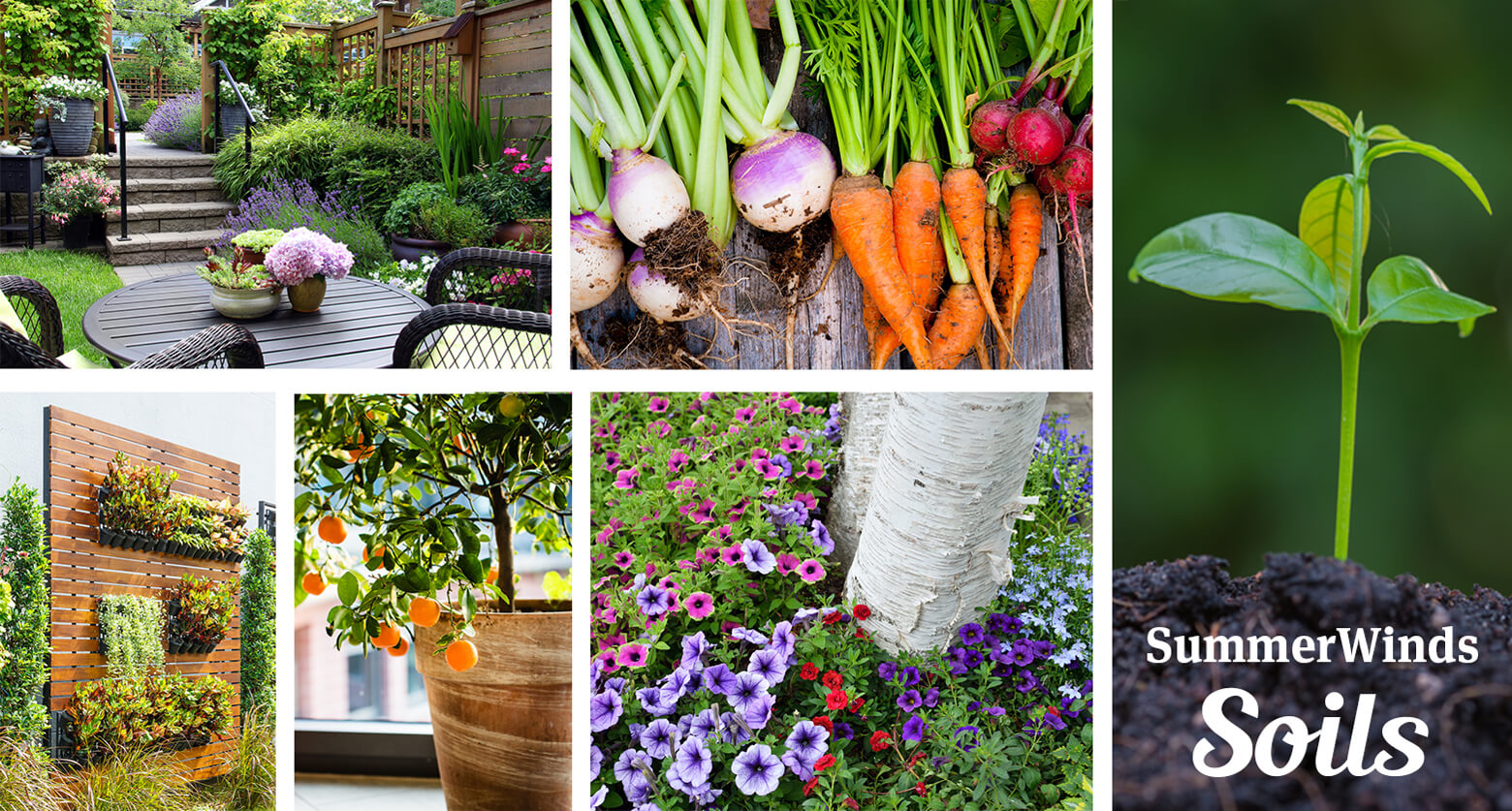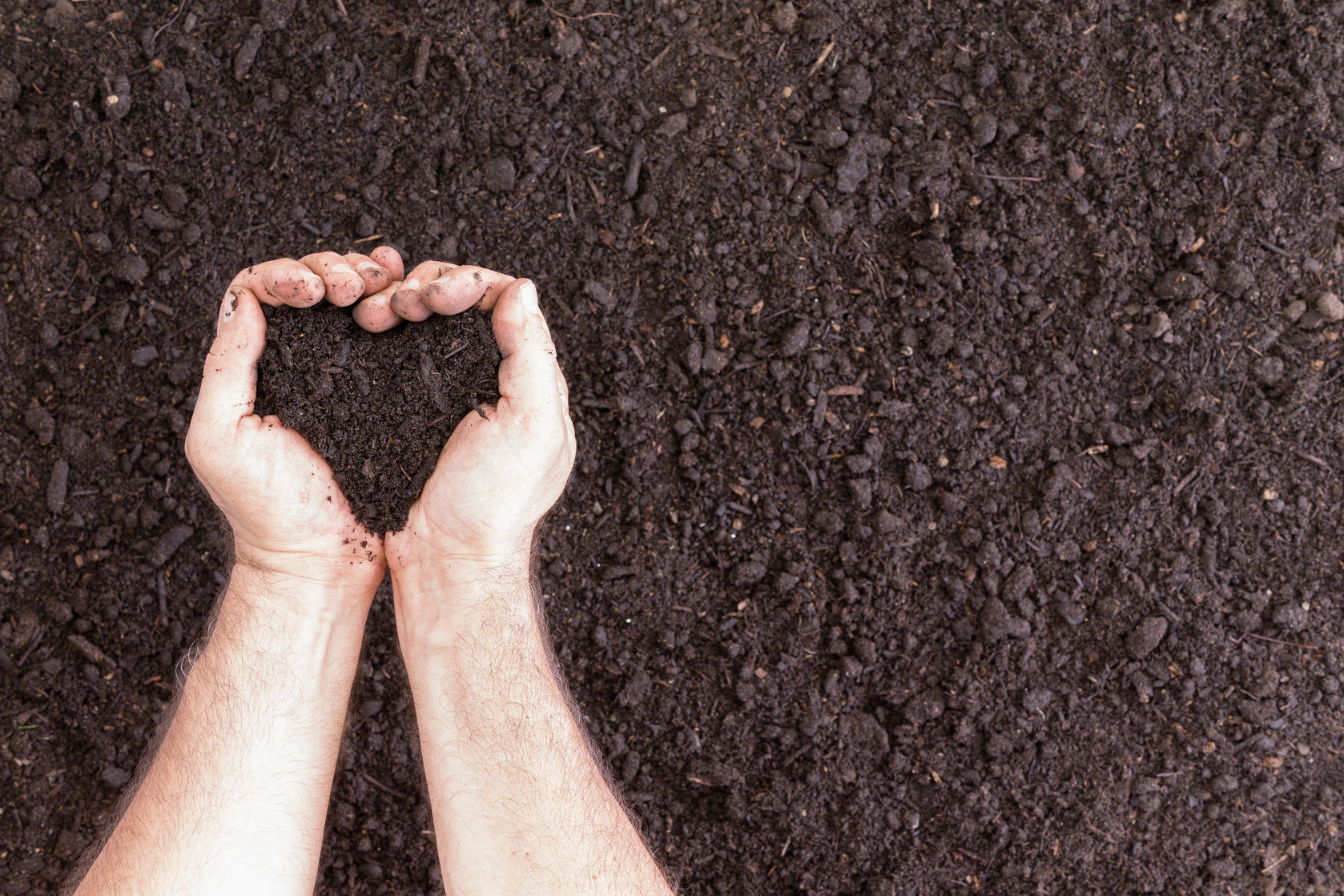 Back to the Be Inspired Blog
Back to the Be Inspired Blog

How to Pick the Right Soil for Your Garden and Keep It Healthy
When planting trees, shrubs, annuals, perennials, fruits and vegetables, the right soil can make all the difference. When you go to your local nursery, you can run into a lot of different types of soil and may not know how they differ. Keep reading for five different types of soil, the best ways to begin using them in your garden and our SummerWinds private-label options that will help your garden flourish.
5 Different Types of Soil
There are five different soil types that gardeners typically work with. All five of the varieties below are a combination of three types of weathered rock particles that make up the soil: sand, silt and clay. How these three particles are combined makes the soil unique—how it feels to the touch, holds water, is managed and more.
- Sandy
Sandy soil has large particles of the different soil types. It’s dry and gritty to the touch, and because the particles have huge spaces between them, it can’t hold on to water. Water drains rapidly, through to places where the roots, particularly those of seedlings, cannot reach. Plants don’t have a chance of using the nutrients in sandy soil more efficiently as they’re swiftly carried away by the runoff. The benefit to sandy soil is that it’s light to work with and warms much more quickly in the spring.
- Silty
Silty soil has much smaller particles than sandy soil so it’s smooth to the touch. When moistened, it’s soapy and slick; when you roll it between your fingers, dirt is left on your skin. This type of soil retains water longer, but it can’t hold on to as many nutrients as you’d want it to, though it’s fairly fertile. Due to its moisture-retentive quality, it is cold and drains poorly. Silty soil can also be easily compact, so avoid trampling on it when working in your garden; it can also become poorly aerated.
- Clay
Clay soil has the smallest particles so it has good water storage qualities. It’s sticky to the touch when wet, but smooth when dry. Due to the incredibly small size of its particles and its tendency to settle together, little air passes through clay’s spaces. Because it’s also slower to drain, it has a tighter hold on plant nutrients, making it rich in plant food for better growth. Clay soil is cold and takes time to warm up in the spring since the water within also has to warm up. The downside is that clay soil could be very heavy to work with when it dries. Especially during the summer months, clay often becomes hard and compact, making it difficult to turn, however when clay soil is worked while it’s too wet, it’s also prone to damage. This type of soil also drains poorly. If moistened, clay soil feels sticky, rolls up easily, and forms into a ball or sausage-like shape; that how you know your clay is in the perfect condition.
- Peaty
Peaty soil is dark brown or black in color, soft, easily compressed due to its high-water content, and rich in organic matter. Although peat soil tends to be heavily saturated with water, once drained, it turns into a good growing medium. In the summer though, peat can be very dry and become a fire hazard. The most desirable quality of peat soil, however, is in its ability to retain water during the dry months, and its capacity to protect the roots from damage during very wet months. Peat contains acidic water, but growers use it to regulate soil chemistry or pH levels; this soil is also an agent of disease control for the soil. When wet peat soil is rolled, you won’t form a ball. It’s spongy to the touch and when squeezed, water can be forced out.
- Saline Soil
The soil in extremely dry regions is usually brackish because of its high salt content. Known as saline soil, it can cause damage to and stall plant growth, impede germination, and cause difficulties in irrigation. The salinity is due to the buildup of soluble salts in the rhizosphere—high salt contents prevent water uptake by plants, leading to drought stress.
 Gardener Preferred Soil
Gardener Preferred Soil
The type of soil that gardens and gardeners prefer is often loamy soil. It contains a balance of all three soil materials—silt, sand and clay—plus humus. It has higher pH and calcium levels because of its previous organic matter content. Loam is dark in color and is mealy—soft, dry and crumbly—in your hands. It has a tight hold on water and plant food, but it drains well and air moves freely between soil particles down to the roots. The feel test for loam yields a smooth, partly gritty, partly sticky ball that crumbles easily. Now that you know the different types of soil, let’s talk about soil health.
Health and Soil
Soil health, also known as soil quality, is defined by the Natural Resources Conservation Service Soils as, “The continued capacity of soil to function as a vital living ecosystem that sustains plants, animals, and humans. This definition speaks to the importance of managing soils so they are sustainable for future generations. To do this, we need to remember soil contains living organisms; when provided the necessities of life - food, shelter, and water - they perform functions required to produce food and fiber. Soil isn’t an inert growing medium, but rather is teaming with billions of bacteria, fungi and other microbes that are the foundation of an elegant symbiotic ecosystem. Soil is an ecosystem that can be managed to:
- Provide nutrients for plant growth
- Absorb and hold rainwater for use during dryer periods
- Filter and buffer potential pollutants from leaving our fields
- Serve as a firm foundation for agricultural activities
- Provide habitat for soil microbes to flourish and diversify to keep the ecosystem running smoothly.”
Determining Soil Health
Of the 17 or so elements thought to be essential for plant growth, nitrogen, phosphorus and potassium are the most important. They are known as primary, or macronutrients, because plants take them from the soil in the largest amounts. Fertilizers that contain all three of these nutrients are labeled complete fertilizers, but they are hardly complete in an absolute sense. Calcium, magnesium and sulfur, known as secondary nutrients, are also important to many plants. Lesser or micronutrients include boron, copper, iron manganese and zinc. Some plant micronutrients have specific functions, such as cobalt, which isn’t used by most plants but helps legumes fix nitrogen. Another critical component of your soil is its acid-alkaline balance, or pH reading. All these essentials and the proper texture make for healthy soil.
SummerWinds’ Natural & Organic Potting Soil
SummerWinds is proud to offer our own private-label soil that delivers quality nutrients at a great savings! Produced locally in a wind-powered factory just north of San Francisco Bay, our soils are custom blended for SummerWinds by E.B. Stone Organics. Our private-label soils are perfectly formulated for all plants, with the bonus of being organic for planting your favorite fruits, veggies and herbs!
Love Container Gardens? We've got just the dirt for you!
SummerWinds’ Natural & Organic Potting Soil is ideal for all types of indoor and outdoor container gardening. Made with natural and organic ingredients, including sphagnum peat moss, perlite, pumice, bat guano, kelp meal and other ingredients for long-lasting results. Perlite allows more air around the roots of your plants, whereas pumice holds vital nutrients while lightening the soil. Our potting soil is loaded with vitamins and minerals. Bat guano and kelp meal provide food for your plants, while feather meal delivers one of the highest sources of naturally occurring Nitrogen to container plants. Available in three sizes: 1.5 cu. ft., 8 quart and 20 quart packages.
SummerWinds’ Natural & Organic Planting Mix
Now is the perfect time to enhance your landscape with new plants! SummerWinds’ Natural & Organic Planting Mix is an all-purpose transplanting mix for all types of flowers, vegetables and ornamentals, including:
- Annuals
- Perennials
- Ground covers
- Shrubs
- Fruit trees
- Shade trees
This nutrient-rich soil helps give your plants a great start! Gypsum helps loosen clay soils, dolomite lime balances pH, and aged bark and rice hulls improve soil texture. Contains: Aged redwood, rice hulls, aged fir bark, aged chicken manure, dolomite lime, bone meal, feather meal, gypsum, alfalfa meal, bat guano and kelp meal. Available in 2 cu. ft. package.
Start Planting!
If you want a successful and flourishing garden, soil is important. The right soil will help you grow fresh, lively flowers, trees, shrubs, annuals, perennials, fruits, vegetables and more. Visit your local SummerWinds Nursery and speak to a specialist that can help you pick the right soil for your needs.

